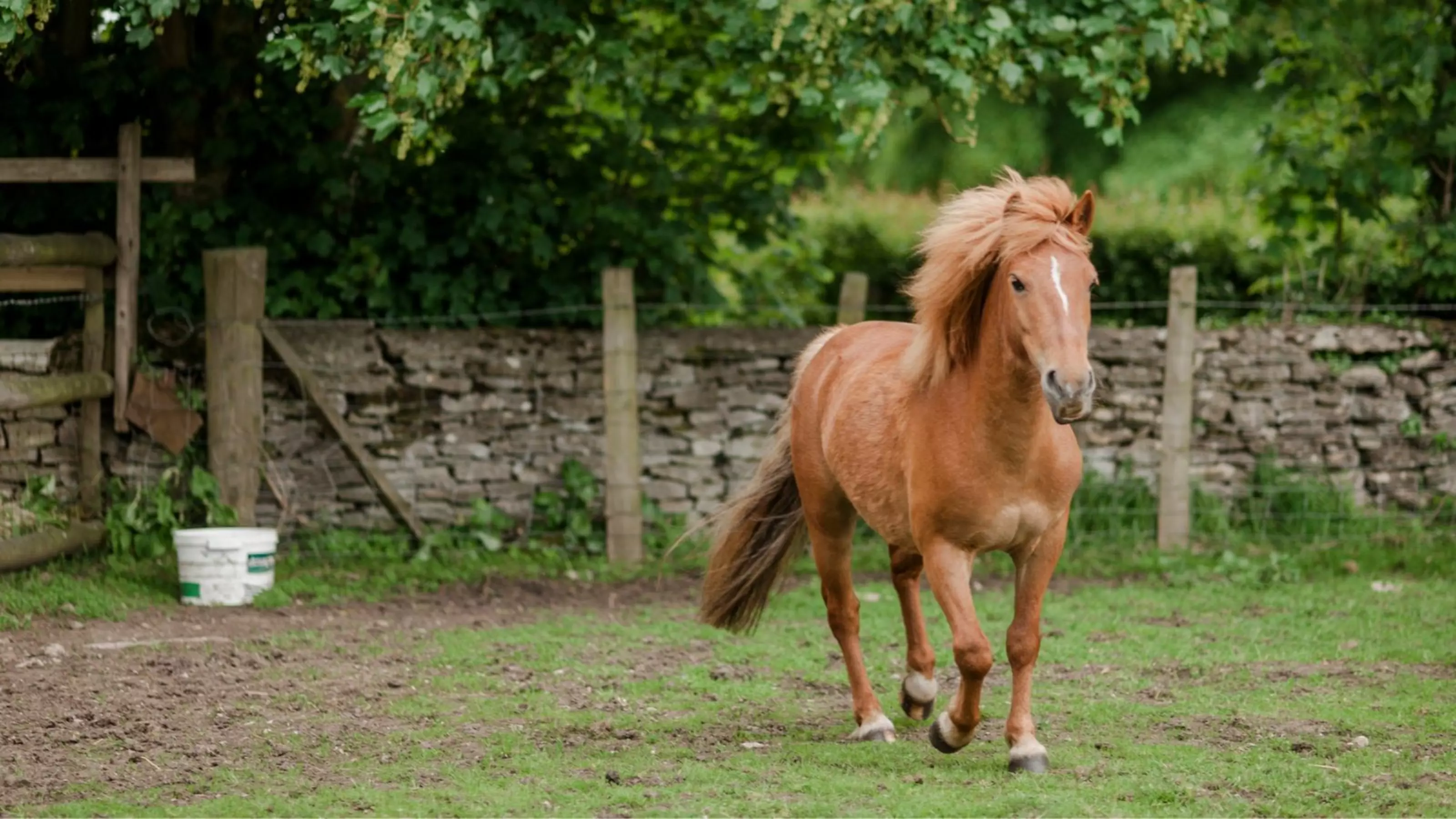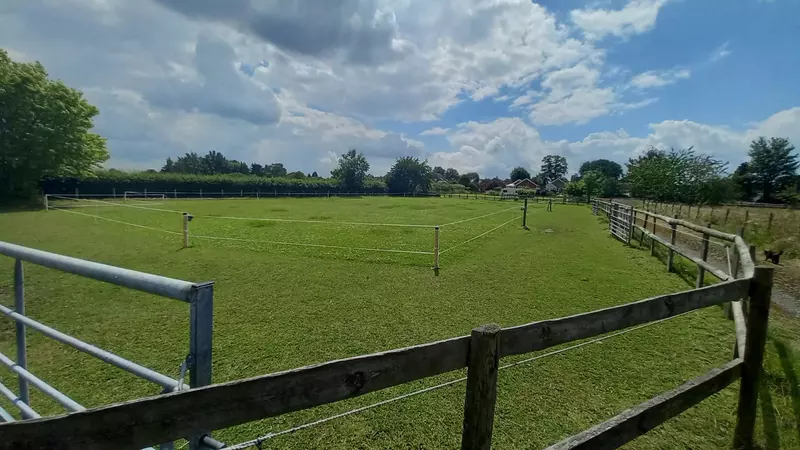
Grazing systems for horses
Choosing the right grazing system for your pasture can help to control your horse’s weight, create a more natural grazing environment, and maintain the health of the grazing.
Grazing horses in traditional field systems has been the normal practice for many years. Recently, some field systems have provided small, individual areas of turnout with few opportunities for horses to express their natural behaviours (such as moving, grazing, loafing and socialising with other horses). These restrictive set ups could be one of the contributing factors of equine obesity, since horses do not have to move far to eat lots of grass.
Many people are now looking for better ways of creating a horse’s natural environment with their turnout. This can improve their wellbeing but is also a useful way to control your horse’s weight, without removing them from grazing altogether.
Setting up an alternative grazing system may not be possible, for example if you keep your horse at a livery yard . They can also be labour and time intensive to set up. But you may be able to use some variations of the suggested systems to benefit both your horse and the land.
Track systems
Instead of a traditional square paddock that does not encourage a horse to move, a track system creates a track running around the perimeter of the field. For horses, eating and moving go hand in hand. In the wild, they would travel up to 30km a day when grazing and finding water. A track system is designed to encourage this natural behaviour.
How to set up a track system
A track system is created by running a fence (such as temporary electric fencing) a few metres from your boundary fence. This pathway should be wide enough for horses to graze together and move past one another. A manmade or natural shelter should be situated along the track, with a separate wider area available for horses to gather, socialise and lie down.
Enriching your track system
You can distribute enrichment along your track system to better simulate a natural environment where wild horses would graze – this can encourage your horse to move and forage.
Enrichment could include:
- hedgerows with horse-friendly plants to add some variety to your horse’s diet
- piles of forage, water and other supplements (such as horse-friendly herbs, branches and minerals)
- a variety of surfaces and terrains, such as dirt for rolling or wood chip for lying down
- obstacles such as small logs and branches for horses to navigate and investigate
- scratching posts (this could be a broom head attached to the fence)
- treat balls
Any obstacles should have space for elderly or less agile horses to move around.
The pros of having a track system are:
- horses are encouraged to move as they graze throughout the day
- the constant movement of the herd can help to reduce the risk of poached areas, such as around gateways
- it’s an effective weight management tool as grass intake can be restricted while movement and activity is encouraged The cons of having a track system are:
- they are not always possible to set up, and are labour intensive
- Some horses may feel restricted and become stressed and, due to the lack of open space, a horse’s flight instinct may be restricted
- the ability to express natural herd behaviour may be restricted
- there may be areas or corners where a horse can become trapped or bullied
- some horses’ grazing needs may not be met on a track system
Equicentral system
The equicentral grazing system combines good land management with natural horse behaviours.
Studies showed that horses graze in bursts of around three hours before switching their behaviour. The equicentral system helps to mimic this natural behaviour by creating a central loafing area of hard standing where horses can drink, eat and find shelter. Several paddocks are all connected to this loafing area so horses have free access. These paddocks are rotated regularly to allow the grazing to rest and recover.
Using this system helps to maintain the health of the soil and grazing, while also allowing horses to choose when they graze and exhibit natural behaviours. By placing all non-grazing activities in one central area, horses are also encouraged to move throughout the day, as they would in the wild. This also reduces poaching in fields where horses may normally gather – for example, when drinking from a trough or standing by a gate.
Since this system relies on constantly improving the land, the pastures become healthier over time.
The pros of having an equicentral grazing system are:
- over time it can help to improve the health of the land, having a lasting impact on your horse’s health
- horses can choose where they go and when
- it reduces poaching in fields where horses may normally gather – for example, when drinking from a trough or standing by a gate
The cons of having an equicentral grazing system are:
- while most horses will naturally regulate their grass intake, some horses may not adjust. Because of this, it may be unsuitable for those with careful weight management needs.
Strip grazing and rotational grazing
Strip grazing is a useful way of controlling your horse’s access to grass while allowing parts of the paddock to rest. It involves sectioning off a part of your paddock using temporary fencing. This way, the horses can only graze the grass that is available to them. The temporary fence is then regularly moved, usually by a little every day – the exact amount is determined by grass growth, your horse’s appetite and the time of year. Since only a small part of the pasture is grazed at a time, the rest of the paddock is rested and allowed to recover.
How to strip graze your field
Strip grazing works best when you have divided your field into three different areas:
- recovering area
- grazing area
- resting area
10 metres as a minimum is a good guideline for each strip.
When the grass has been eaten down, you can move the electric fence posts out by approximately one metre. This places a new strip of grass in the grazing section, and a grazed strip is incorporated into the resting area. Both the fences of the grazing area should be moved at the same time. This is so the area does not become too big and overgrazed.
Over time, the strips will be moved back and forth across the field, allowing each section time to rest and recover.
When setting up a strip grazing system, you’ll need to consider:
- the size of the strip for the horses. There needs to be sufficient room for free movement, turning around, passing each other, and normal herd behaviours with the risk of any bullying. If the strips are too large your horses grass intake will not effectively managed.
- additional enrichment. Similar to a track system, a range of surfaces, grazing opportunities and free movement can be incorporated into a strip grazing system. This helps to create a more natural environment for your horses.
- new grass growth. Grass that is stressed by overgrazing can be very high in sugars. Make sure the grazed area is not over grazed before the fence is moved. When horses are given new grass each time the fence is moved, some may be encouraged to gorge on the new grass once it available which could be more detrimental to some horses or could cause colic.
Page details
Published
• 9 October 2023
Next review
• 9 October 2026






